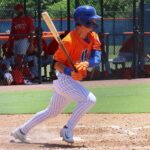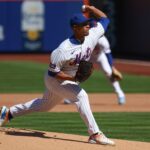
New York Mets outfielder Jay Bruce has ended up as one of numerous ill-fated offseason signings from last winter. Sandy Alderson and company brought him in to be a stabilizing force in the middle of lineup with Yoenis Cespedes, but that didn’t happen one bit (also because Cespedes couldn’t stay healthy, but that’s a story for another day).
While the three-year, $39 million deal he signed still seems to be more of a burden than an asset moving forward, he at least showed signs of life upon returning from the disabled list in August.
Hip issues and plantar fasciitis put Bruce on the shelf in the middle of June, and with the way his season was going at that point, it was probably for the best. Despite entering 2018 fresh off hitting a career-high 36 home runs — along with reaching 30-plus dingers in two straight years — he was a shadow of the hitter New York thought it signed. His first 236 plate appearances back in the orange and blue produced a horrendous .212/.292/.321 triple slash with just three dingers and 17 RBI, leading to a 71 wRC+.
Upon his return to the big-league roster following two-plus months on the disabled list, Bruce finally started to look like the player the Mets thought they signed in the offseason. Although his second half consisted of just 125 plate appearances, the veteran slashed .243/.344/.467 with more homers (six) and more RBI (20) than the first portion of his year, leading to a 123 wRC+.
What changed? When looking at some of his plate-discipline stats and batted-ball profile, it doesn’t seem like there is much of a difference at all.
| 2018 | PA | K% | BB% | LD% | GB% | FB% | Hard% |
|---|---|---|---|---|---|---|---|
| First Half | 236 | 20.3% | 10.2% | 23.3% | 31.3% | 45.4% | 32.5% |
| Second Half | 125 | 21.6% | 13.6% | 24.7% | 22.2% | 53.1% | 34.6% |
There also wasn’t much of a shift in Bruce’s overall contact rate (72.4% in the first half to 73.2% in the second half) or BABIP (.261 to .267). What did change, though, was his performance on balls in the air that he pulled.
Of the balls Bruce pulled in 2017, he produced a 50.0% line-drive rate, 50.0% fly-ball rate, and 56.5% hard-hit rate, which led to a 475 wRC+ and .891 ISO. His cumulative numbers in each of these categories took a nosedive this year, but he at least got himself going in the right direction upon returning from injury.
| 2018 | LD% | FB% | HR/FB% | Soft% | Hard% | ISO | wRC+ |
|---|---|---|---|---|---|---|---|
| First Half | 66.7% | 33.3% | 8.3% | 2.8% | 41.7% | .194 | 218 |
| Second Half | 59.1% | 40.9% | 33.3% | 9.1% | 50.0% | .591 | 335 |
It’s not exactly at his 2017 levels — and the sample size is obviously much smaller — but that was an important piece of his offensive production he needed to regain (21 of his 36 homers from last year came in this situation). This at least provides hope that maybe he can be productive to a degree if he’s on the club’s Opening Day roster next March.
A strong end to the season is never a bad thing, but it just adds to the uncertainty around how portions of the roster will eventually shake out. Peter Alonso and Dominic Smith are options at first base, while Brandon Nimmo, Michael Conforto, Juan Lagares, and hopefully at some point, Cespedes, will make up the outfield mix (without thinking about any potential additions).
Could Bruce handle first base on a more regular basis? It seems possible, as even Keith Hernandez provided some confidence in that notion during Sunday’s telecast.
At the very least, his added versatility gives Mickey Callaway some options, although it’d likely come at the expense of someone like Alonso. Depending on how the winter goes, this strong finish could also potentially make him a trade candidate. It’s not like the Mets wouldn’t have to kick in some cash to necessitate a deal, but this would be a way to clear some room on the roster, pending whatever the offseason plan is going to be.
Many important decisions need to be made in Queens if the organization does have designs on contending next year, and what to do with Bruce will be one of them. Before any of that happens, of course, they’ll have to first put someone in charge to actually lead the way.















